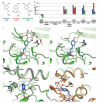Structure-guided directed evolution of highly selective p450-based magnetic resonance imaging sensors for dopamine and serotonin
- PMID: 22659321
- PMCID: PMC3418479
- DOI: 10.1016/j.jmb.2012.05.029
Structure-guided directed evolution of highly selective p450-based magnetic resonance imaging sensors for dopamine and serotonin
Abstract
New tools that allow dynamic visualization of molecular neural events are important for studying the basis of brain activity and disease. Sensors that permit ligand-sensitive magnetic resonance imaging (MRI) are useful reagents due to the noninvasive nature and good temporal and spatial resolution of MR methods. Paramagnetic metalloproteins can be effective MRI sensors due to the selectivity imparted by the protein active site and the ability to tune protein properties using techniques such as directed evolution. Here, we show that structure-guided directed evolution of the active site of the cytochrome P450-BM3 heme domain produces highly selective MRI probes with submicromolar affinities for small molecules. We report a new, high-affinity dopamine sensor as well as the first MRI reporter for serotonin, with which we demonstrate quantification of neurotransmitter release in vitro. We also present a detailed structural analysis of evolved cytochrome P450-BM3 heme domain lineages to systematically dissect the molecular basis of neurotransmitter binding affinity, selectivity, and enhanced MRI contrast activity in these engineered proteins.
Copyright © 2012 Elsevier Ltd. All rights reserved.
Figures





References
Publication types
MeSH terms
Substances
Associated data
- Actions
- Actions
- Actions
- Actions
- Actions
- Actions
- Actions
- Actions
- Actions
- Actions
Grants and funding
LinkOut - more resources
Full Text Sources
Research Materials

